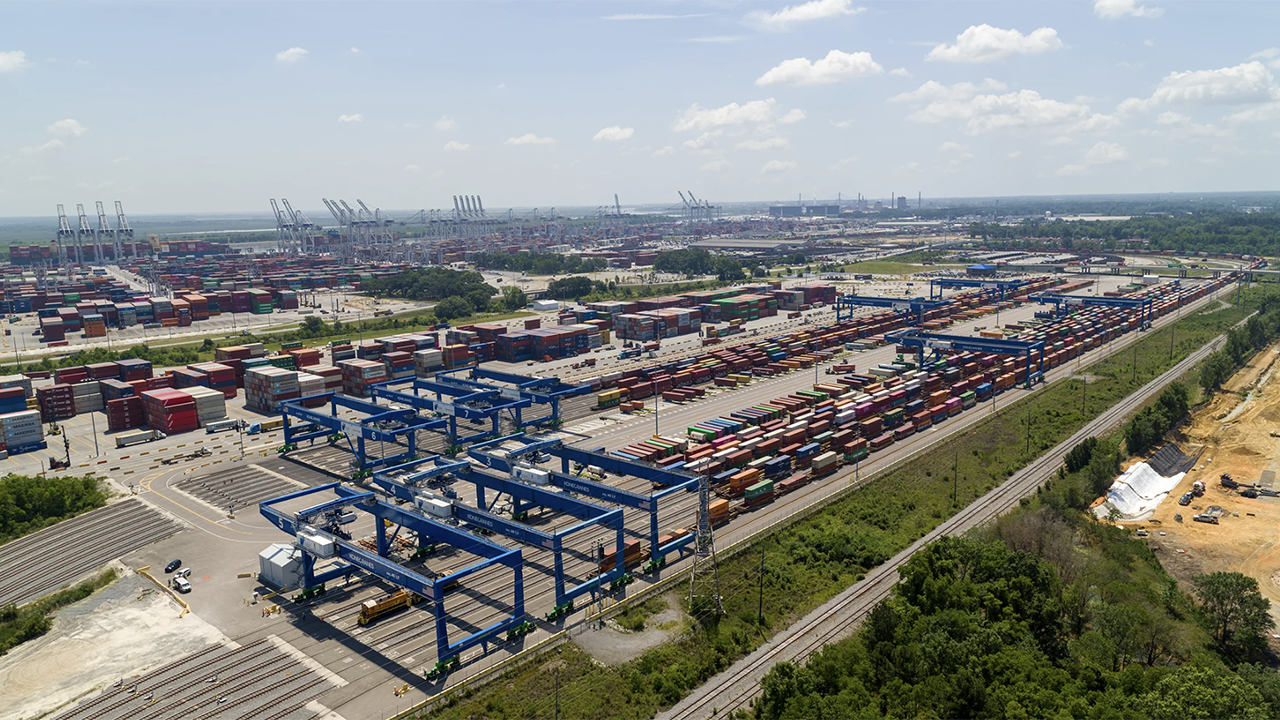
Intermodal Briefs: GPA, SC Ports
Written by Marybeth Luczak, Executive Editor
The Port of Savannah set a February record of nearly 47,000 containers moved by rail, according to GPA. (GPA Photograph)
February was the second consecutive month of growth for the Georgia Ports Authority (GPA), with rail accounting for 19% of container trade. Also, South Carolina Ports (SC Ports) advances rail-capacity projects.
GPA
GPA on March 4 reported handling 451,670 TEUs (twenty-foot equivalent units) in February, an increase of 14.4% (56,880 TEUs) over the same month in 2023. Loaded imports came in at 219,000 TEUs, up 19%, and export loads were 121,930 TEUs, up 10% from last year.
This was the second consecutive month of growth, according to GPA, which noted that despite “a challenging start to the fiscal year, the improving volumes should carry GPA to a stronger second half of Fiscal Year 2024, ending in June.”
Intermodal rail cargo set a February record in Savannah, Ga., GPA reported. Rail volumes at the port’s Mason Mega Rail Terminal ramped up to 46,890 containers, an increase of 39% or 13,060 lifts compared with February 2023. The Norfolk Southern (NS) and CSX-served facility features 24 miles of track on 85 acres at the Port of Savannah’s Garden City Terminal. Its $220 million development increased the port’s rail capacity to 1 million containers per year, rerouted trains away from neighborhood highway/rail grade crossings, and brought rail switching onto the port, according to GPA. The expanded rail capacity speeds intermodal cargo handling and extends GPA’s inland service area.
Rail accounted for 19% of GPA’s February container trade, with the remainder moving by truck.
“GPA has made significant investments in rail infrastructure,” GPA President and CEO Griff Lynch said. “That’s going to play a key role in capturing our next growth target—a greater share of the market in locations such as Dallas, Memphis and beyond.”
GPA also reported that the Appalachian Regional Port (ARP) in Northwest Georgia set a February record, “thanks in part to an increase in the import of manufacturing components.” ARP handled 3,285 containers last month, up 23% or 610 containers. According to GPA, ARP provides an alternative to an all-truck route to and from the Port of Savannah. Its target markets include regions of Georgia, Alabama, Tennessee and Kentucky.
Further Reading:
- For GPA, Container Volume Down in December, ‘Renewed Strength’ Expected in 2024
- GPA Approves $127MM for Blue Ridge Connector
- GPA Prepares for the Future, Adds Inland Rail Connectivity
- CSX, GPA Launch ‘Carolina Connector’ Service
- Georgia Ports Advances Inland Rail Hub Plan
SC Ports

Construction at the future Navy Base Intermodal Facility and expansion at Inland Port Greer are under way, SC Ports reported Feb. 29.
The Navy Base Intermodal Facility, which is slated to open in North Charleston in July 2025, will be equipped with six rail-mounted gantry cranes to move containers on and off CSX and NS trains.
“Growing rail capacity in the Port of Charleston will further enhance South Carolina’s competitiveness, ensuring our customers can swiftly move goods to market,” SC Ports President and CEO Barbara Melvin said.
In Upstate South Carolina, the expansion of Inland Port Greer has already yielded more than 8,000 feet of additional rail track, and the container yard expansion is nearing completion, according to SC Ports. These terminal enhancements, it said, double Inland Port Greer’s cargo capacity.
“We move nearly a quarter of our containers by rail today,” Barbara Melvin said. “We look forward to growing this percentage by building critical rail infrastructure and terminal capacity in South Carolina. These projects will further support the billions of dollars being invested in South Carolina by port-dependent businesses.”
While total U.S. container volume declined in 2023, SC Ports said its intermodal volume increased nearly 12% last year, “demonstrating a compelling rail product for ocean carriers and cargo owners.”
According to SC Ports, its RapidRail program “expedites containers between ship and train, with imports moving to rail less than 24 hours from actual vessel discharge.”
Inland Port Greer and Inland Port Dillon achieved the highest January on record, moving a combined 17,656 containers, SC Ports reported. The inland ports provide direct rail service to and from the Port of Charleston.
Within SC Ports’ container terminals at the Port of Charleston, SC Ports handled 208,538 TEUs and 115,744 pier containers in January. “This is down slightly from last year and reflective of the softened volumes seen across the U.S.,” SC Ports said.
January was a strong month for the vehicle segment, it added, with 17,614 vehicles rolling across the docks, up 32% year-over-year.
Further Reading:
- Intermodal Briefs: Port of Los Angeles, SC Ports
- Intermodal Briefs: SC Ports, Port of Los Angeles
- Intermodal Briefs: SC Ports, IANA
- Intermodal Briefs: SC Ports, Port Houston, Port Milwaukee



